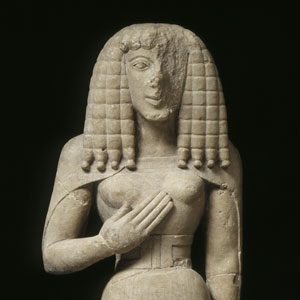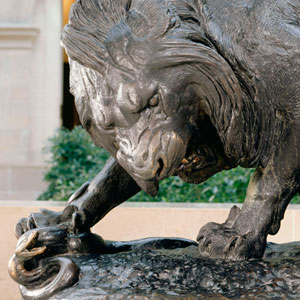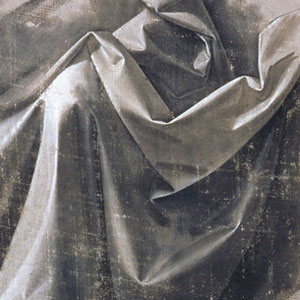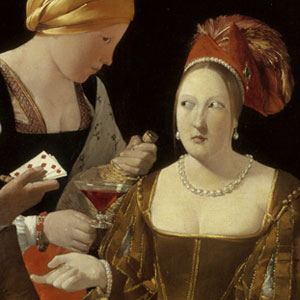Get Art Smart








Female statuette known as the Lady of Auxerre
Did You Know?This ancient Greek masterpiece was once used as a stage prop.
Get Art SmartBrought to France by a collector, then purchased at an estate sale for one franc by a theater concierge, this seventh-century B.C. statuette ultimately wound up in a museum in Auxerre, Burgundy. There it was put on display, of a sort, employed as a hat rack. A Sorbonne professor spotted it for the treasure it was-one of the earliest examples of ancient Cretan tomb sculptures-and brought it to the Louvre in 1907. Today, it is prized as a consummate masterpiece of early Greek sculpture.
Johannes Vermeer—The Astronomer
Did You Know?It took 200 years before Vermeer became a bold-faced name.
Get Art SmartAlthough his work was always esteemed, Johannes Vermeer's reputation languished for more than two centuries as tastes changed and art lovers looked elsewhere. In the mid 19th century, a connoisseur and author returned the Delft master's paintings to prominence, where they have remained ever since. This painting is one of a diptych-or pair-featuring scientists, long separated by a French royal who believed that owning a single work of the type was plenty. Thus proving that hindsight-even for Louis XVI-is 20-20.
Antoine-Louis Barye—Lion with Serpent
Did You Know?This sculpture was hailed a masterpiece from the moment it was finished.
Get Art SmartTo ensure authenticity, Antoine-Louis Barye sketched hundreds of live and autopsied lions, a study he undertook with fellow artist Eugene Delacroix. Barye also pushed the boundaries of his medium, bronze. Instead of its being assembled from several smaller pieces, as most large-scale works are constructed, Lion Crushing a Serpent was created by one bronze pour into a single mold. Commissioned for the Tuileries Gardens in Paris by King Louis-Philippe, this original sculpture won instant popularity. Barye copied it hundreds of times in many sizes.
Leonardo da Vinci—Drapery Study
Did You Know?Even da Vinci's homework was masterful.
Get Art SmartLikely drawn while the young artist apprenticed in Florence, this drapery study illustrates da Vinci's outstanding ability to shade and model form armed with nothing more than a student's black-and-white tempera brushwork on linen. It is an icon of Western art, one of six such studies held in the Louvre's collection. Its masterly technique hints at da Vinci's most famous work, the Mona Lisa, which he painted some 30 years later and is also at the Louvre.
Antonio Pisanello—Hunting hawk hooded and perched on a gloved left hand
Did You Know?This drawing was made by Italy's great draftsman. No, the other one.
Get Art SmartThe drawings of Antonio Pisanello were frequently mistaken for those by Leonardo da Vinci, especially as the latter's stature grew-along with the value of his work. In his own time, Pisanello (the "little Pisan") had been among the most revered of Italian artists. Although few of his works survive today, those that do show the artist's gift for capturing nature and movement. His work was forgotten for more than 400 years, until an Italian scholar rescued him from oblivion in the 1880s. Today, Pisanello's elegant and precise works are in a league of their own.
Georges de La Tour—The Card-Sharp with the Ace of Diamonds
Did You Know?You're not only witnessing the card game. You're in on the cheat.
Get Art SmartA popular parable, this type of card-playing scene first appeared in the art of Caravaggio. Thanks to Georges de La Tour's masterful lighting and dramatic composition, the action is played out to full effect and extends even beyond the frame. The victim sits at right, his finery and youthful naivety making him an obvious mark. The fellow at left reveals the contents of his hand as well as the ace stashed in his belt. The viewer, now in on the con with the card-sharp, courtesan, and wine-pourer, has a front-row seat to the deception.
Peacock Dish
Did You Know?This peacock dish has every reason to strut and preen.
Get Art SmartThis Turkish dish is one of the finest examples of Iznik ceramics anywhere. Painted with a masterful flourish, both delicate and striking, it features one of the earliest known combinations of flora and fauna in Islamic art. It was created during the zenith of the Ottoman Empire, which once ruled the lands from Central Europe to the Indian Ocean. Made and painted by hand, it is an outstanding example of what's now known as the Golden Age of art produced under the reign of Süleyman the Magnificent.
Franz Xaver Messerschmidt—Character Head
Did You Know?The artist who made this self-portrait glanced in the mirror every half minute.
Get Art SmartFranz Xaver Messerschmidt created his Character heads series in the late 18th century, during the Age of Enlightenment, a period of moral and social reform throughout Europe. The sculptures have been viewed as both "an outward expression of the artist's melancholic genius," as well as a reflection of his time. Mental illness forced Messerschmidt into seclusion, yet it was a period of heightened creativity for the artist; his self-imposed exile yielded this remarkable grimacing bust of himself, and dozens of others that are similarly masterful.


